































































Embarking on the open water is an exhilarating experience, flled with the promise of adventure and relaxation. Whether you’re a seasoned sailor or a weekend cruiser, protecting your vessel with proper insurance is not just a choice—it’s a necessity. Explore the reasons why every boat owner should prioritize boat insurance for a worry-free voyage.


The open water can be unpredictable, with unexpected storms, collisions, or other potential accidents. Boat insurance can give you fnancial protection if there is damage to your vessel, providing coverage for repairs or replacement.
Accidents on the water can result in damage to other boats, docks, or even injuries to passengers. Boat insurance offers liability coverage, which can pay for damages or injuries you’re liable for while boating, up to specifed limits, and lawsuit costs if you’re sued. This includes damage you cause to another watercraft or if someone on or near your boat is injured and you’re found to be legally responsible.
Unfortunately, boat theft and vandalism are realities that boat owners face. Boat insurance has comprehensive and collision coverage that can protect you against events outside of your control, including theft and vandalism.
Accidents on the water may lead to injuries for you or your passengers. Boat insurance offers a range of optional medical payments coverage limits, helping to cover medical expenses if you are in an accident or someone is hurt on your boat, regardless of fault.
If you fnanced the purchase of your boat, most lenders require insurance coverage to protect their investment. Having boat insurance not only fulflls these requirements but also gives you peace of mind knowing that your fnancial interests are safeguarded.
Some water municipalities and marinas may require proof of insurance for docking or accessing certain areas. Boat insurance allows you the fexibility to explore different destinations without worrying about entry restrictions.
Emergency towing and assistance
Progressive boat insurance can include optional Sign & Glide® On-Water Towing coverage. If your boat is disabled or breaks down on the water, Sign & Glide® pays for on-water towing, jump starts, soft un-groundings, and fuel delivery.
Wreckage removal
If your boat sinks, Progressive boat insurance will cover the cost of removing your boat from the water (if removal is legally required).
Investing in boat insurance is not just about protecting a valuable asset; it’s about safeguarding the memories, experiences, and joy that come with your on-water adventures. Don’t let unforeseen circumstances disrupt your journey—navigate with confdence, knowing that Progressive boat insurance has you covered. Ensure a smooth and worry-free voyage, because when it comes to your boat, peace of mind is the ultimate luxury.
Scan to get a quote in as little as 4 minutes
learn more.


























The quest to find the ultimate men’s watch has traditionally been a difficult one in the world of fashion. A timepiece with the perfect look and functionality has long been the goal of both watch designers and enthusiasts alike.
The Renegade Blue Chronograph Men’s Watch is the perfect combination of style and function. With a sleek design that features a bold blue dial, rose gold hands and hour markers, and a durable sports silicone band, this timepiece will instantly elevate any outfit.
The three sub-dials provide a precise timekeeping function. The sports silicone band is durable yet comfortable, providing a secure fit that won’t slide around on your wrist. The band is also easy to clean and maintain, making it perfect for everyday wear. The watch’s 30 Metre Water Resistance rating ensures that it has you covered whatever the occasion.
The Renegade Blue is also built to last, with a sturdy stainless steel caseback and exquisitely detailed bezel. The watch is powered by a super reliable quartz movement, which is covered by our incredible 5 Year Movement Warranty - ensuring accurate timekeeping for many years to come!
At the amazingly low price of just $99 plus S&H, this watch is an absolute steal. Don’t miss out on the chance to own the Renegade Blue and Rose Gold Chronograph Men’s Watch - order yours today!





By Dr. Benjamin Cole


Tarpon (Megalops atlanticus), known as “silver kings,” are renowned for their acrobatic leaps and strength, making them a top target for anglers. However, their fascinating migration patterns also play a crucial role in maintaining marine ecosystems.
Tarpon migration is largely driven by the need for feeding and reproduction. Tese highly
migratory fsh can travel thousands of miles, infuenced by water temperature, food availability, and spawning needs. Preferring temperatures above 72°F (22°C), tarpon move south during colder months, seeking warmer waters.
the U.S. Atlantic coast, they travel from Virginia to Florida and the Caribbean, while in the Gulf, they move from Texas and Louisiana to Mexico. Teir northward migration begins in late spring, driven by rising temperatures and abundant food. By summer, tarpon reach as far as Virginia, signaling the start of fshing season. As fall sets in, they return south to warmer wintering grounds.
A key driver of tarpon migration is spawning, typically occurring between May and September in ofshore areas with strong currents. Afer spawning, larvae are carried into estuarine environments like mangroves and marshes, crucial nurseries for juvenile tarpon. Tese habitats are essential for the species’ survival, but environmental degradation threatens their health.
While tarpon are primarily a catch-andrelease species, improper handling during fshing can lead to mortality. Conservation eforts, including safe fshing practices and habitat protection, are essential for sustaining tarpon populations. Organizations like the Bonefsh & Tarpon Trust work to monitor migration, protect critical habitats, and promote responsible fshing.

Found in the Atlantic Ocean and Gulf of Mexico, tarpon migration varies by region. Along
Tarpon migration is a remarkable journey, driven by the search for favorable conditions. By protecting these iconic fsh and their habitats, we can ensure their survival and preserve their role in marine ecosystems for future generations.

Capt. Russ Walker

If a fsh can see the bait, they’ll hit it much faster than if they must search through grass or mud. Tat’s why I rig to suspend the bait, keeping it above the bottom where fsh can easily spot it. Grass fats are incredibly productive fshing grounds, and targeting the edges where the fat drops of into deeper water is the key to catching bigger fsh.
In around fve to six feet of water, grass growth stops, forming a natural erosional edge where fsh like trout, cobia, tarpon, and mackerel hunt. Tese edges act like a “superhighway” for predatory fsh. While smaller fsh are found on the fat, the big ones hang near the edge, diving into the deeper channel when necessary.
Te best tool for this fshing method is a fat-topped popping cork. Te cork keeps the bait suspended at the desired depth and makes a popping sound when tugged, drawing fsh to the noise. Tis is especially useful for beginners, as it’s an easy technique that produces great results. With just a few pops, the live shrimp below the cork will jump into plain sight, attracting the fsh.
As a charter captain, I’ve found this method efective for anglers of all experience levels. It’s not uncommon to catch 80 to 100 fsh during a four-hour trip using this rig. It works equally well ofshore near wrecks, suspending bait for species like permit.

I make my own 200 lb. rated, fat-topped popping bobbers, stronger and shorter than store-bought versions. Tey’re perfect for fshing

everything from trout to tarpon, with only the hook size and leader changing. Te leader length is always four and one half feet, and the magic depth on the grass-fat edge is fve feet.
Typically, I use a 3/0 Mustad Wide Gap Hook with a 1/4 oz. egg sinker and a 30 lb. fuorocarbon leader. Tis rig works wonders for trout, pompano, mackerel, snook, redfsh, and ladyfsh.
So, give it a try! Pop the cork a few times, remove the slack, and hang on. When the bobber disappears, just “yank it and crank it.” You’ll see your catch increase by at least 40 percent. Fish On!
Capt. Russ Walker is a USCG Masters licensed fshing guide and owner of Tide Walker Charters out of Cape Coral, FL. www.tidewalkercharters.com


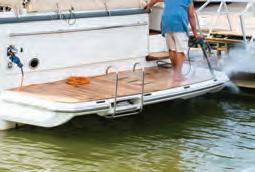











By A. deGruchy


The Florida Keys transform into a fishing paradise as the intense summer hurricane weather fades and cooler fronts begin to roll in. This fall, it’s all about the patch reefs... vibrant underwater gardens teeming with a variety of species. Targeting these patches is incredibly fun and rewarding. You’ll encounter species like snapper and grouper, along with various types of mackerels. Light-action fishing is always a blast,
and in the Keys, there are countless patch reefs to explore.
To find a patch reef, look for shallow spots scattered with coral and sand, typically just a few miles offshore at depths of typically between 1530 feet. For gear, we recommend using a PENN Spinfisher VII 3500-4500 combo. The Mustad 3/0 Demon circle hooks are reliable, and when it comes to bait, live shrimp are unbeatable. It’s all about enjoying the vibes and seeing what you can reel in... mutton snapper, red groupers, porgies, Spanish mackerels, and much more!


This fall will be even more special with the opening of Three Waters Resort in Islamorada. This elegant new destination offers not just stunning accommodations but also brand-new restaurants and a magnificent ambiance. Imagine savoring fresh culinary experiences while soaking up breathtaking waterfront views. After a day on the water, kick back and enjoy a drink at one of the resort’s dining venues or onsite restaurants.
So come on down this fall and get ready for some fun fishing in the Florida Keys. With Three Waters Resort as your home base and Bean Sportfishing Charters as your vessel, you’ll be hooked on the fishing, the food, and the laid-back vibes!






















By Capt. Jack Gohmert

Creating your own chum bait can signifcantly boost your fshing success. Chum, a mixture of fsh parts and attractants, draws fsh to your spot by creating a feeding frenzy. Making your own chum lets you tailor it to the fsh you’re targeting and saves money. Here’s a simple guide to making efective chum and using it for the best results.
Chum is a blend of fsh-based materials that attract predatory fsh. When
placed in water, it forms a scent trail and visual signal that lures fsh like snapper, tuna, and sharks. Whether you fsh ofshore, from a pier, or inshore, chum helps by concentrating fsh around your location.
Making chum is straightforward. You’ll need the following:
Tools:
• Food processor or meat grinder
• Bucket or container
• Rubber gloves
• Freezer bags (for bulk storage)
Ingredients:
• Fish scraps (bait lefovers, carcasses)
• Canned fsh (sardines, mackerel, or tuna)
• Fish oil or menhaden oil
• Breadcrumbs or oats (to bulk up the mix)
• Optional: sand or cornmeal (to sink chum faster)
1. Gather Fish Scraps: Collect lefover fsh scraps or use canned fsh. Local fsh markets are great for sourcing discards.
2. Grind the Ingredients: Use a food processor to grind fsh scraps into a paste. For canned fsh, mash it along with the oil for a strong scent trail.
3. Add Bulk: Mix in breadcrumbs, oats, or cornmeal to bulk up the chum. Tese ingredients absorb oils and create a scent cloud. Sand can help sink the chum.
4. Enhance the Scent: Stir in fsh oil to intensify the scent, making it travel farther underwater.
5. Pack and Freeze: Freeze large batches in bags. When fshing, break of chunks and toss them into the water.
For ofshore fshing, throw small amounts of chum every few minutes to create a steady attractant. For shore or pier fshing, use a chum bag or cage to suspend and slowly release the chum. Adjust the size and consistency of your chum based on the fsh species. Larger fsh prefer coarse chum with chunks, while smaller fsh may respond better to a fne mix that creates a cloud.
Making your own chum is a cost-efective way to improve your fshing. With minimal tools and ingredients, you can craf a bait that attracts fsh and turns a slow day into a successful one.



By: Jessica Hendrie

Fish tails. They’re more than just a fish’s rear end, they’re like the engine. The drive. All of them range from size to color to shape and they help them zip around the ocean, of course. But tails don’t just help the fish swim, they fuel the greatest sport ever, exaggerating fish tales. So, what are the basics? Fish tails are also called caudal fins, essential for propulsion. (The more you know) whether a tuna making a quick dig through the ocean or a sailfish racing by you, the strong tail is what drives them. Now onto the real art form, fish tales. Because every angler knows, catching fish is only half the battle. The other half is telling your friends and family about it, and that’s where the tail, I mean tale, gets bigger. Remember that 2-pound mahi mahi you caught in Puerto Rico? Yeah, me either. It was a 50 pounder that fought like a big White Marlin. And nobody will question you, or will they? Maybe they won’t let you know. Fish tails and fish tales have a lot more in common than you might think. Just like a tail propels the fish, a tale propels your reputation. How many of us has held the fish closer to the camera, don’t lie, I seen it! In truth, fish tales are the best to tell children. It’s so fun to watch their facial expressions as you tell them about a great giant you reeled in on a stormy day with rain coming down and waves rolling over. They will talk about it forever and it will forever be a core memory for them. After all, it is all in the tail! To conclude, whether it’s a fish tail powering a 40 pound grouper or a fish tale impressing your 8 year old son, never underestimate the back end of a fish. At the end of the day, without a good tail, what’s the point? Happy Fishing!

By: Capt. Bart Marx

The hot summer season has winded down and it is a great time to get some serious fishing in. Close to shore and inshore we need to be on the lookout for those convicts, the sheepshead. They should be on the move going into the Gulf to spawn. They will be piled up on any structure that has food like pilings with barnacles and small oysters. As they migrate into the Gulf, they will gather around the close to shore reefs and small ledged up and down the coast. Flounder that are doing a similar thing, as they tend to hang out on the sand holes and the edges of the sandbars where there is moving water that brings bait like shrimp or small fish. While searching for these species we should have no trouble finding a redfish to tug on your line and test your drag for you, and if you are drifting the grass flats you should encounter some speckled trout. The natural bait this time of year is shrimp. Years ago, we would start in November to get shrimp nets out and make sure that they were in good shape, and this will go on till March. On all of my trips, I always bring shrimp for bait, even in the summer I’ll bring live shrimp. I buy the middle grades of shrimp as the big ones get eaten by the small fish before the bigger ones find it, and the small shrimp get ripped off to quick. This time of year, the greenies may head offshore as they don't like the cold water inshore. Sliding offshore when there is good weather, there may be some of those smokers around that are lots of fun to catch. Look for the big schools of bait offshore. Most of the time I catch them while you are bottom fishing. You put the bonus rod out with some wire on it those guys have a mouth full of razor blades. This month look for the tripletail hanging on the stone crab trap buoys. Shrimp works well casting to them with no weight, and you may use artificials too like DOA shrimp. Speaking of bottom fishing, if you would like to target some hogfish, you will need to have shrimp or small crabs as they eat crustations. The target area would start in 40 ft. around natural ledges and artificial reefs. While in search for those guys you should find some lane snapper and mangrove snapper. There should be some white grunts and porgies there too. If you may be interested in coming along with Capt. Bart Marx, give me a call 941-979-6517 or e-mail me at captbart@alphaomegacharters.com

By: Capt. Dave Stephens

This time of the year in Southwest Florida normally brings cooler weather, and a lot less rain. With the slowing of the rain and less freshwater running into the harbor, the saltwater will begin to push further up into the harbor, and also into the river mouths. As the water cools, a lot of the top game fish such as snook, red fish, and even some tarpon will start migrating to the north. Snook are going to have the biggest effect of this migration. During the cooler months of late fall and winter these fish seek deeper water. Charlotte Harbor has countless miles of man-made canals on the northern end of the harbor, and there are also many deep natural creeks that will hold fish. As the water cools, I recommend slowing down you're fishing technique. Spend a little more time working the area that you're fishing. Live bait will work well, but so will large live shrimp, also small paddle tails fished slow along the bottom do very well.
Going back to the local creeks, a migration of reds will begin to move into these areas. For the most part these are what we call rat reds. This is due to fact that mostly all of the fish are under 19-20”, however the action can be very good. The best bite seems to be on shrimp fished on a jig-head. The color of the jig seems to me to be a personal preference, however, I do recommend using one with a nice hook and enough weight to make contact with the bottom. I highly recommend you contact your local tackle shop, let them know what species you plan to target, and they will get you set up correctly to have a successful outing.
If you would like to experience some of Southwest Florida's finest fishing, give us a call or send an email. Our trips are private and customized to fit you and your party's needs.









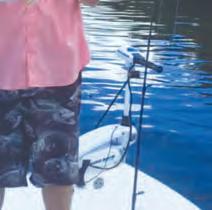
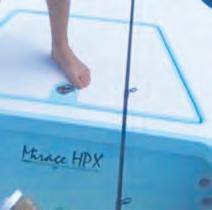


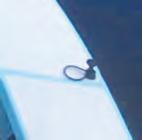

By: Capt. Terry Fisher
The last couple of months have prevented many from fishing due to excessive heat, tropical depressions, hurricanes, rains, high winds and limited harvesting of inshore and offshore species. I am looking forward to this month as hurricane/storm season winds down and sub-tropical temperatures fade away. The fish are active and remain in good numbers. Know the rules for harvesting fish. Tide levels still allow access to ‘skinny’ locations, docks and seawalls prior to the coming winter months.
L ook for things to begin to ‘chang-up’ in late November as we approach the first month of our winter in December. Early November should continue to offer great opportunities for redfish, snook, seatrout and mangrove snapper for inshore anglers on the higher tides. Weather permitting, offshore anglers will have a better chance at nice size groupers and snappers in water depths from 50-100 ft. as opposed to the deeper summertime depths of 130-160 feet. Numerous ‘pods’ of bait fish are offshore and proof the waters of Southwest Florida are healthy. Grouper, snappers and other reef species are plentiful. Look for the pelagic permit and king mackerel to be coming through our waters as well.
October yielded a good number of redfish with big bull reds. The snook bite was good as were the seatrouts and mangrove snappers. Throw the arrival of triple tail into the mix this month to make scouting and catching them fun experience(s) for anglers, not to mention fishing guides as well. November will be one’s best chance of scoring a ‘redfish of a lifetime’. The strategies to find and catch these fish rarely change but there are a variety of ways for both artificial presentations, live or dead baits.
My Recommended Strategies for Catching Big Redfish;
1. Fish the top half of the higher of the two daily tides around points of spoil islands and oyster beds. Fish in close!
2. Be quiet when moving in on a ‘spot’ to fish, as the bigger Redfish spook easily, they did not get ‘big’ by being ‘lucky’. Change locations frequently after 15 minutes or so if they are not biting, odds are they are not there or on a break.
3. Fish when the wind direction is in your favor for making a presentation.
4. Do not hesitate to re-fish previous locations that were non-productive earlier in the day or night. Fish move with water levels, water temperatures and to areas with food and protection.
5. Fish will bite on artificial, live, or dead bait presentations. Artificial presentations require the ability to move around and cover
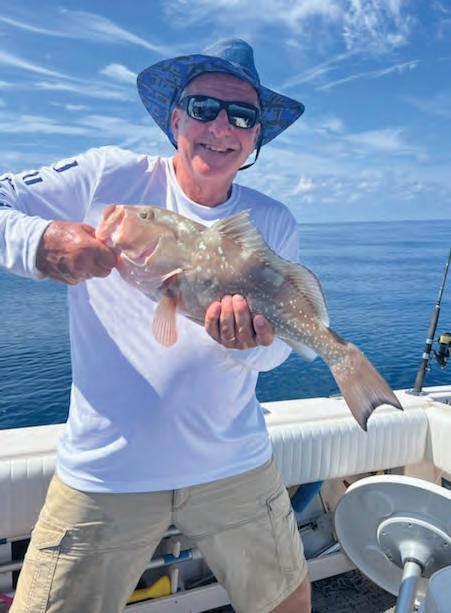
a lot of ground. Live bait or dead bait presentations, on the other hand, give anglers the opportunity to sit and wait a little longer in an area. However, both methods require moving to and from several areas to find the fish.
6. There are a number of live and dead baits that work, such as pilchards, pinfish, ladyfish and finger mullets. They may be presented live or ‘cut’. Some of the best artificial presentations include gold spoons and paddle tails, scented or unscented.
7. Do not arrive to fish the mangroves too early or too late. Most of our tides are in six (6) hour increments. Fish 3 hours before tide tops out or 3 hours after high tides. During a moon phase that supports a very high tide, allows the fish to seclude themselves deep into the mangroves. Conversely, the fish will be swimming out to the potholes on a low tide when there is not enough water to house them under the mangrove and other debris, thus making them harder to locate. It Is common sense That on a high tide they will be somewhere under or close to the mangroves as there is both food to eat and protection from enemies such as birds.
The Annual Fort Myers Boat Show is scheduled for November 14th -17th this year. 1ST Mate Vicki will be inside the Convention Center to greet clients and guests as they peruse the booths in search of any products that are marine related. I’ll be presenting fishing seminars at a location inside the convention center and invite everyone to checkout the times and subject matters for inshore, offshore and tarpon fishing. This year I will be joined by my fishing friend and counterpart, Captain Jay Rodriquez of Salty Native Fishing Charters here in Cape Coral and Ft. Myers. We will be rotating on an hourly basis discussing inshore and offshore fishing techniques that guarantee catching fish. The hourly seminars are sponsored by Coastal Angler Magazine, and will start daily at 10:30 through 3:00 PM.
I a m available as ‘Captain for Hire’ on your vessel by the hour for safety, navigational, fishing techniques and locations. Check out my website at www.fishfacecharters.com. Contact me by phone at 239-357-6829 or email me at fishfacecharters@yahoo.com with any questions or to confirm a date on the water on your vessel or mine. This is Captain Terry Fisher wishing you ‘tight’ lines!


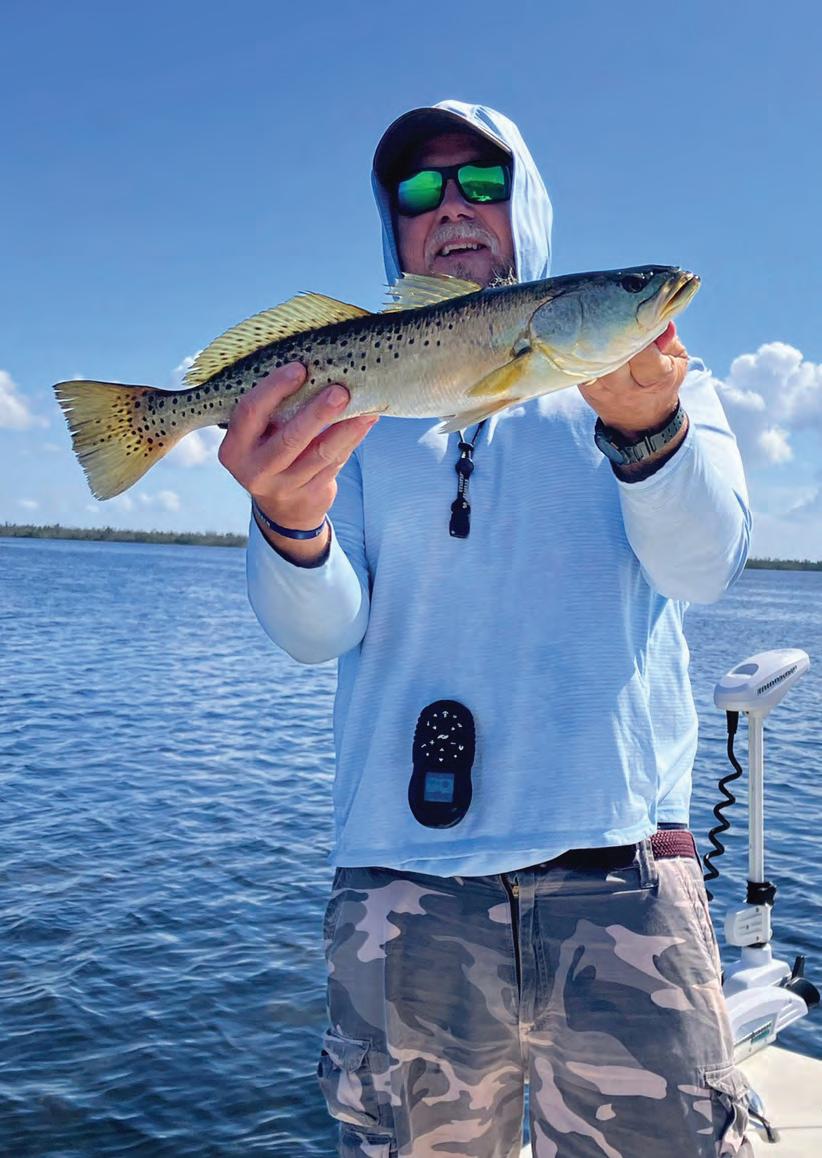
By: Joe Sheaffer
attern fishing, what does that mean? How do anglers figure out the pattern? Many anglers have these types of questions and are looking for answers that will help them be productive. That information can be helpful but many times it probably doesn’t help all that much. Fishing in tidal waters creates changing conditions daily if not hourly. Many times, I may have a great day of fishing, go back the next day and it is totally different and much tougher. Fishing reports can definitely be helpful but most of the time each day presents different conditions and challenges. Whenever I’m on a fishing adventure, I’m trying to figure out a pattern that will produce a consistent bite. Some days there isn’t much to figure out, the fish are biting, and it seems the fish will bite anything. Unfortunately, that doesn’t happen that often at least for me. Most days I have a plan for my day on the water, then I’m trying to figure out a pattern that will help me make that day productive. I usually will start with current flow, looking for areas where water is moving. Current can be caused by tidal flow, wind or funnel areas. Bait plays a huge role in figuring out a pattern, usually if there is a bait presence there will be predators around. Other factors that affect a pattern are water levels, water temperature, seasonal trends and water clarity to name a few. Most of the time when I figure out a solid pattern, it will hold up throughout the fishing trip. I can cover water or run to specific areas and catch fish. There are times when the pattern may change while I’m fishing, usually because the tide is changing. There are situations where the pattern totally changes, and I may need to figure out something else or call it a day. To be totally honest, there are days I never really figure out a pattern. There are times when grinding a fish here and there is all I can do. I consider myself a pattern fisherman, figuring out the puzzle each trip can be a challenge but so rewarding when I can put the puzzle together. Have a plan and take mental notes as you fish. Many times, one bite can be the clue that keys you into a great day of fishing. Good luck and keep casting!




3
13
20
21
22
25
26

































































5



































































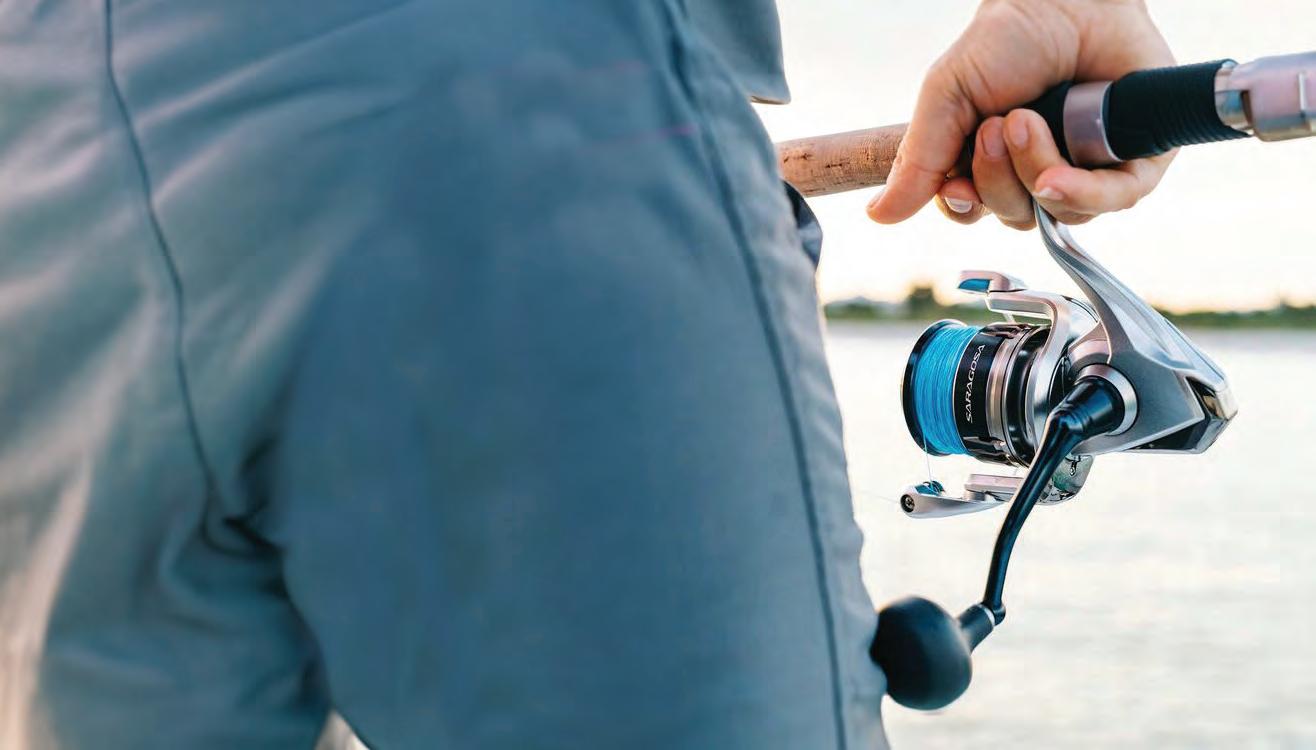
By: Caitlyn Gatrell
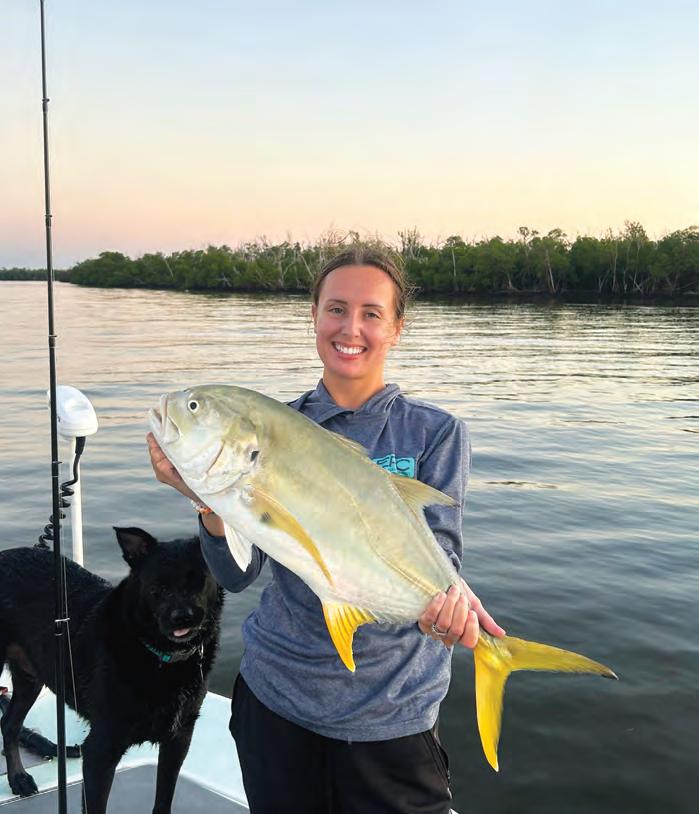
Every angler has different preferences when it comes to what’s considered a “good catch”. Most think of lengthy gamefish and some might think of anything that’s big. For me, I look at it as a mix of both. One species in particular we’ll focus on is jack crevalle. They might not be considered a gamefish, but one fact about them is they are very strong, no matter the size! So, when I hook up to a large one and I feel my arm muscles get tight, I think of that as a good catch. Do you?
Recently I was able to get a new personal best Jack while out fishing. My fiancé and I brought our pups out for our German Shepherd’s birthday, and I always say, they are our good luck charm. We were able to catch snook, redfish, trout, tarpon, goliath, and my new best jack that day!
The jack was the first catch of the morning and boy did it put on a show. After we loaded up on mullet at our favorite bait spot, we were making our way towards one of our honey holes when we came across a school of rolling tarpon. We came in slowly and quiet and threw out our bait. Not only could we see a bunch gulping air around us, but there was a lot of topwater action also.
As we quietly sat and waited, soon I felt something hit my bait hard, and the line started to take off. I jumped up hoping it was a tarpon but after no jumps and a specific tug, I knew it wasn’t a silver king. I could feel the fish digging and it would take off when it would get closer to the boat. My gut was telling me jack or shark and sure enough with that first surface movement I could see it was a pretty nice sized jack. Of course, it took off a couple times, so I had to fight it for a bit before I was able to bring it into the boat. I was a bit nervous with all the action as we have seen plenty of sharks over there! But I was able to get it in, take a few photos, and release it without the tax man showing up.
I felt great after fighting that fish and my arms felt like they had a little workout! While jack may not be as hype as a trophy snook or a feisty tarpon, I still love when I get to hook up to a big one and I encourage others to look at it the same!


by: Dan Carns

Saltwater fishing is an exciting sport, especially if you come from a freshwater background. I began my fishing life as a child fishing the ponds and streams of Georgia and Alabama under the patience of my father George, but eventually moved to coastal New England where saltwater fishing rules. Some of you are just beginning to experience the joy of saltwater fishing. While many aspects of this sport simply transfer from fresh to salt there are some things that will change, including

the gear and the lures. Sure, we salties use topwater baits, spoons, and swimbaits but they tend to be larger and certainly the fish can be much bigger, even too big for the gear we carry! I know several accomplished freshwater tournament anglers like @wendy_biles_fishing and @ amybrownfishing that are suddenly trying out saltwater fishing and are having great success.
In areas like New England, you will typically be chasing a specific species and may catch a couple of additional types of fish but if you are fishing anywhere in Florida the number of possible fish species is suddenly huge and may include fish you’ve never heard of or seen. I would recommend that you start out chasing some in-shore species like snook, redfish and spotted sea trout as they are easy to reach in a kayak. They also tend to hit the same types of lures as largemouth and smallmouth bass. You may also be able to use your more stout freshwater rods. As your saltwater experience grows you can then start to target sharks, tarpon and grouper but will need to upgrade your rods and reels. Don’t be surprised if one or all these species end up on the end of your line even in shallow water.
W hile you may be an artificials only type of angler, bait is a surefire way to catch dozens of different species. By bait in mean primarily shrimp, live or frozen. It’s super easy to create a cheap live well out of a sheetrock bucket and a battery powered bait bubbler. Of course, if you’ve got a way to keep bait alive then pinfish, crabs and pilchards are also highly effective baits.
I would be remiss not to mention the toll saltwater has on your gear so be prepared to leave most of your freshwater fishing reels behind unless they are high-end and resist saltwater. Nothing will corrode a freshwater reel faster that a little dunk in saltwater. As kayakers we are super low to the water and as we reel up line, water is dripping on the reels as well as drenching the rod eyes in salt. I personally use all Penn (2500 - 4500 series) Spinfishers for my reels as they are super resistant to saltwater intrusion. Gently spray a little freshwater on the rods and the reels, dry with a terry-like cloth and then use a line/reel lubricant like Superslick or Reel Magic.
It’s A Wild World-Get Out There!
@paddlinandfishin
Dan Carns



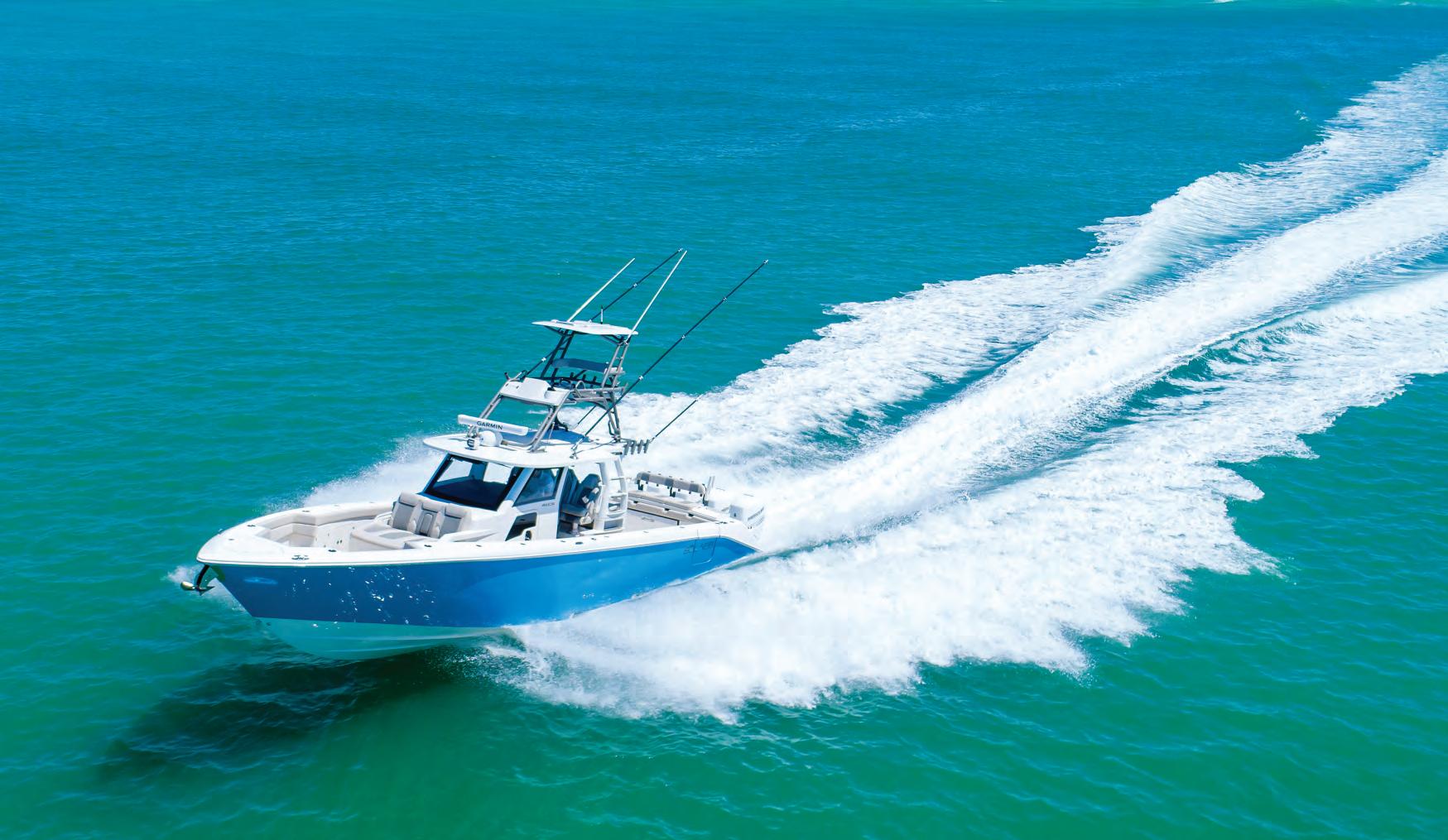
able. If you are buying a new PFD for yourself or your child, take the time to make paddling motions. If there is any rubbing or discomfort with “air


paddling,” try to adjust the PFD straps to see if you get a better fit. Even minor rubbing while at the store can become very irritating after paddling for a while on the water. If you can’t get comfortable with the PFD, try another. Try all the appropriate life jackets you can to find the best fit. Many of my SUP friends wear inflatable belt PFDs to help eliminate overheating. Inflatable PFDs can be a great option if you understand their limitations and how they work.
or one of our young summer camp kids on a short paddle, seatbacks may not be a big issue. For adults on a paddle of any distance, a properly adjusted seatback is crucial for comfort. Some of the kayak seats available are more comfortable than my office chair. I wish I had one now. If you are outfitting your boat, find what works for you.
If renting or borrowing a boat, take the time to adjust the seat to make it as comfortable as possible before leaving shore. If you or someone in your group finds themselves in a rental kayak with a faulty seat, ask for another. Trying to paddle while in mid sit-up position is not fun and can become
y children would tell me they did not need to bring their hats and sunglasses but would be happy to ask for mine after we were on the water. It became mandatory they bring their own “just in case.” This saved me from getting headaches from squinting into the sun after giving up my sun
t’s hard to convince people that paddling is wonderful while they’re being devoured by a swarm of mosquitos or no-see-ums. Some of my favorite places (mangrove tunnels) and times (sunrise and sunset) to paddle are also the favorites for biting bugs. Having a repellant that works and can be shared will make the paddle much more enjoyable. Sharing repellent at the launch can make you a hero when the no-see-ums show up. There are many other considerations for comfort. Clothing, size of gear, distance of paddle, snacks… Just remember safety first, but keeping yourself and other paddlers comfortable will have everyone wanting to get out on the water for another paddle.




Convention Center Over owing with Engines, Electronics, Marine Services, Fishing Seminars’ Gadgets Apparel & More

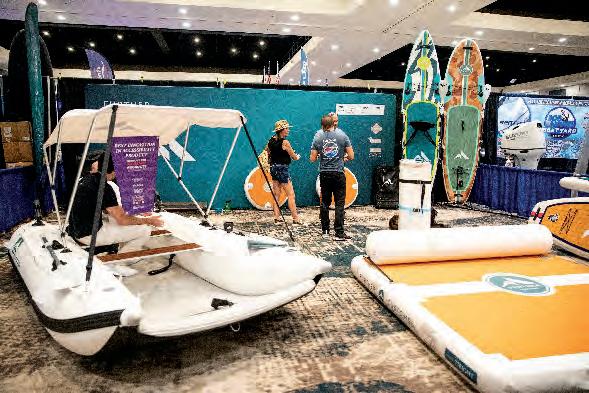







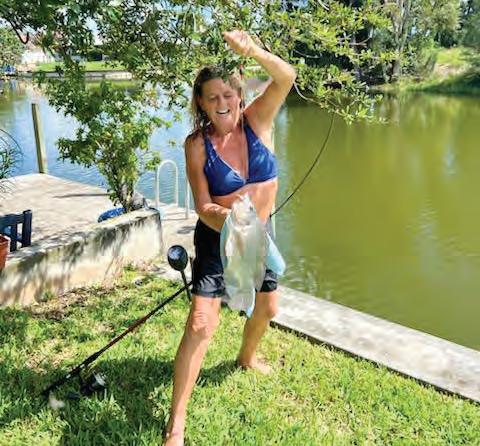





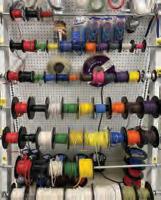
















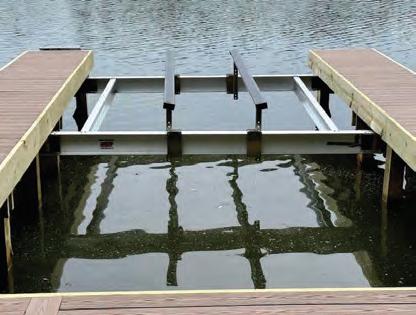




ShoreStation hydraulic boat lifts are a reliable choice for coastal residents and boating enthusiasts alike. Their strong construction, made with corrosion-resistant materials, allows them to withstand harsh environmental conditions, including sun, storms, and saltwater damage. ShoreStation provides a steadfast solution for protecting waterfront investments, ofering peace of mind to owners in the Sunshine State.
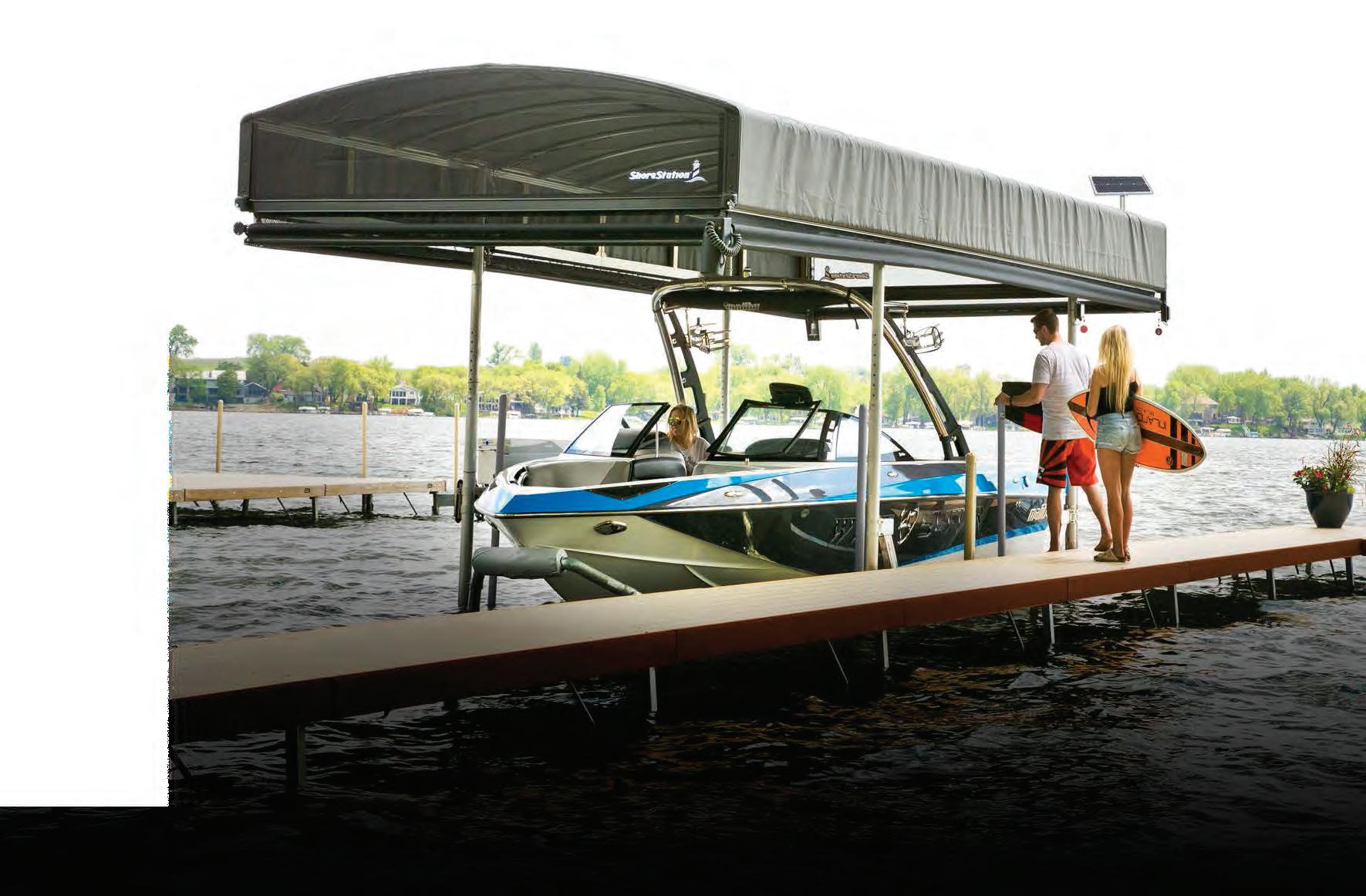







Equipped with exceptional weather resistant fabric and breathable SunTex 80 woven mesh ends for maximum protection and durability,

Made from the highest quality materials, our innovative hydraulic boat lift is one of the fastest and safest lifts on the market today. When you have a hydraulic lift, there’s no need to worry about wind and waves getting in your way. This lift will give you confdence to safely land and secure your boat in less-than-ideal conditions.
Never miss another moment on the water. Power your lift with clean, free solar power. Our speedy 20 watt charger features solar regulator drainage protection, saving your battery from permanent damage caused by overcharging.





















By Dr. Sal Benezo






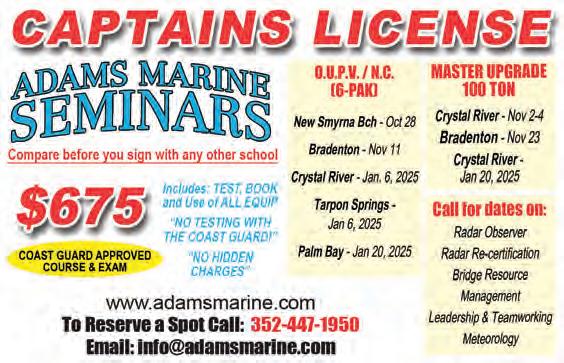
During a hurricane, fsh experience dramatic changes in their environment that can afect their behavior, habitat, and survival. As the atmospheric pressure drops with an approaching hurricane, the water pressure at diferent depths also changes. Fish have swim bladders that help regulate buoyancy, and the rapid changes in pressure can afect how they swim and maintain their depth. Some fsh may dive deeper to avoid the surface turmoil.
Hurricanes churn up sediment from the seabed, making the water murkier. Tis can reduce visibility, afecting how fsh fnd food and avoid predators. In coastal areas, this turbidity can also carry pollutants and toxins from land runof, negatively impacting the water quality.
Hurricanes generate powerful underwater currents and massive waves. Many fsh seek refuge in deeper waters, coral reefs, or underwater structures to avoid being swept away. Shallow-water fsh may struggle more to fnd shelter from the turbulence, which could lead to displacement or death.
Hurricanes ofen bring a rapid infux of fresh water from rain and runof, lowering the salinity of coastal waters. Some species, especially those adapted to certain salinity levels, may be stressed or forced to move to more stable areas. Additionally, the mixing of ocean layers can lead to changes in water temperature, which can afect fsh metabolism and spawning behaviors.
Te disturbance of the water column can disrupt oxygen levels, particularly in areas where organic matter from land washes into the ocean. Decomposing plant material can deplete oxygen in the water, creating hypoxic (low oxygen) zones, which can force fsh to fee or risk sufocation.
Fish, especially schooling species, may instinctively move to safer waters before or during a hurricane. Some species seem to sense the change in barometric pressure and migrate to deeper or more sheltered areas ahead of the storm. However, fsh that get caught in the turbulent water may end up displaced far from their usual habitat.
Afer a hurricane, habitats may be altered signifcantly. Coral reefs, seagrass beds, and mangroves—essential fsh habitats—can be damaged, leading to long-term impacts on fsh populations. However, hurricanes can also bring benefts, such as replenishing nutrients and oxygen in certain water bodies, which can stimulate plankton growth and temporarily improve food availability for fsh.
Fish have evolved to withstand many natural disturbances, including hurricanes, but the intensity and frequency of storms can have lasting efects on fsh populations, particularly for those in fragile ecosystems.



TRACY PATTERSON
Costa Rica is a renowned destination for anglers, ofering calm seas, ideal fshing conditions, and worldclass fshing. It is especially popular among female anglers due to its safety, tournaments, and supportive crews, making it an unforgettable experience.
If you’re seeking high odds of catching billfsh, Costa Rica is the place to be. On a full day ofshore, it’s common to get multiple strikes. Te fat, calm seas make it enjoyable for anglers of all levels, letting you focus on reeling in catches rather than battling rough waters.
Costa Rica hosts two ultra prestigious women-only tournaments: the Ladies Angler Tournament at Los Suenos Resort and Marina, and the Pescadora Billfsh Championship at Marina Pez Vela. Both tournaments create a supportive

yet competitive environment for anglers of all skill levels. Te Pescadora Championship is
particularly unique, ofering two Female Angler of the Year awards based on diferent fshing techniques. It encourages women to challenge themselves and grow in the sport.
Costa Rica is ranked #1 in Central America for safety, and recent laws further protect women from harassment. Female anglers can feel comfortable walking around resorts and marinas. Charter feets also adhere to strict safety regulations, ensuring peace of mind while on the water.

Whether you’re staying at a boutique hotel or a private home, Costa Rica ofers a range of accommodations for groups of all sizes. Many resorts are conveniently located near marinas, allowing easy access to fshing trips and other adventures.
Costa Rica is home to many women who support the lady angler movement. Te captains and crews are eager to teach beginners, helping them hook their frst billfsh or refne their skills. With women accounting for a growing percentage of anglers, Costa Rica ofers a welcoming and empowering environment for female anglers.
Whether you’re an experienced angler or a frst-timer, Costa Rica ofers an unbeatable fshing experience. Its exceptional conditions, tournaments, safety, and camaraderie make it the top destination for lady anglers.






IBy Capt. Michael Okruhlik
t’s that thrilling time of the year, founder time! Te fall migration, reaching its peak in November along the Gulf Coast, promises an exciting infux of founder to their spawning grounds. Louisiana, following Texas, has also implemented a closed season during this peak run. But remember, the inability to keep fatties during this time doesn’t dampen the thrill of catching them.
Flounder will be migrating into the Gulf during this time, so the apparent ambush areas will be around passes that lead to the Gulf. Te founder will position themselves in diferent regions based on the tide level and current strength. In addition to using their burying-in-the-sand ambush technique, they also utilize structure in several ways.
First, any object that protrudes above the bottom is a great ambush point. Tis ofers a current break for forage fsh to gather directly above a buried founder, making for an easy meal. Objects such as bulkheads are also great ambush points. Flounder like to position themselves against the solid barrier and I think this can be for two separate reasons depending on what other factors are at play. As mentioned above, it could be a current break, especially if the bulkhead has a corrugated shape. When a founder settles against a bulkhead, its prey has less direction in which it can fee, allowing the founder greater odds of capturing it. When targeting founder, never pass up a bulkhead.
Secondly, founder can be caught using a variety of lures and live bait, especially if you keep it in contact with the bottom to increase your chances of a strike. When it comes to live bait, a frisky mullet is your best bet for landing a larger founder. If you’re aiming for a trophy, this is the way to go. Personally, I prefer fshing with lures, particularly the paddle tail style. Jerk-style sof plastics and bucktails can also be efective when worked in the same manner.
If I had to pick a tide to maximize my time on the water, I would choose a medium fow outgoing. Although there are no set rules that fsh always follow, I feel the founder feed more on their way out to the gulf, utilizing

the current to ease their journey. Contrary to the incoming tide, they bury themselves rather than fght against the current.
Don’t let the closed season discourage you from targeting founder during this migration; it will have its advantages. Going forward we will undoubtedly have a larger founder population, but the instant gratifcation will be a lot less trafc in our favorite founder spot! I will use the closed season to target a new personal best this season, as should you.
Capt. Michael Okruhlik is the inventor of Knockin Tail Lures® and the owner of www.MyCoastOutdoors.com.











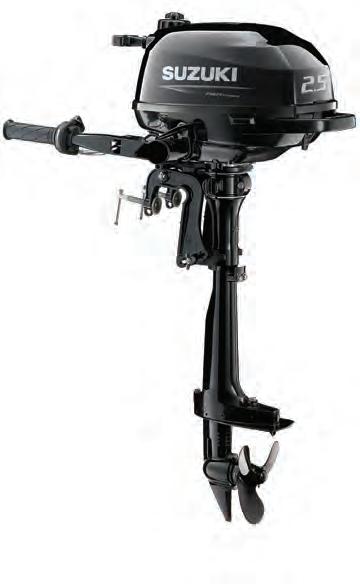



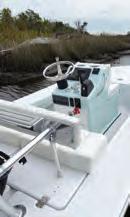







OTim Barefoot

f course, October is when it all starts, but if you like to bottom fsh, then November is the month the turbo kicks in, leading to the crescendo of the year… December. I’ve always said the week of Christmas is the apex of the grouper fshing calendar, and I’ll stand by that statement now. Tis is when larger (male) gags move inshore to establish their territory on inshore ledges, wrecks, and live bottom, much like buck deer making scrapes and rubs to mark their territory. Tese males now wait for the smaller females to show up in numbers to spawn, and the bite traditionally goes of the charts.
A small piece of hard bottom can attract large numbers of fsh if it contains the right ingredients. First and foremost, you need to locate their food. Go to the places that have traditionally held the bait—cigar minnows, sardines, beeliners, etc. “Find the bait, fnd the fsh” has been my thought process for years. Tese fsh won’t show up to a party without food—common sense. You can anchor up on a stack of bait without seeing a big mark of fsh, but afer a few bites, you’ll notice the screen light up with more and more fsh showing up.
Anchoring up is key to shallow water grouper fshing. Te sound of fsh feeding travels great distances and doesn’t go unnoticed. Once an area is fred up, constant bites supercharge the atmosphere down there. If you’re drifing, you won’t get a specifc area fred up; you’ll only go back where you got bites. But if you anchor, the fsh come to you to join in. Tis draws the alpha predators—big sharks. Yes, you’ll lose some fsh and tackle to these bruisers, but enjoy the ride while it lasts. When sharks show up, it’s time to move on to another ledge or further down the same one.

Back to noise... Keep in mind that while we hear very little, fsh hear everything. Sound travels far underwater, and everything you do on deck—slamming cooler lids, dropping hard objects, loud music, yelling—is heard by the fsh. It could be the diference between catching smaller cows or big bulls. Large male groupers didn’t get old by being dumb. You don’t kill big bucks by being noisy, so treat your fshing with the same respect.
Te folks that target grouper come home with grouper. Te ones who go “bottom fshing” with cut bait and chicken rigs come home with “bottom fsh.” As Franklin Covey said, “begin with the end in mind.” If you’re targeting grouper, think and act like it. Put baits on the bottom that avoid trash bites. Spend time jigging up some of that “trash” and drop them back down on a Decoy Jig for optimal results. Watch some of my videos on YouTube (Tim Barefoot) for examples of what I’m saying.
For more information, visit barefootcatsandtackle.com.





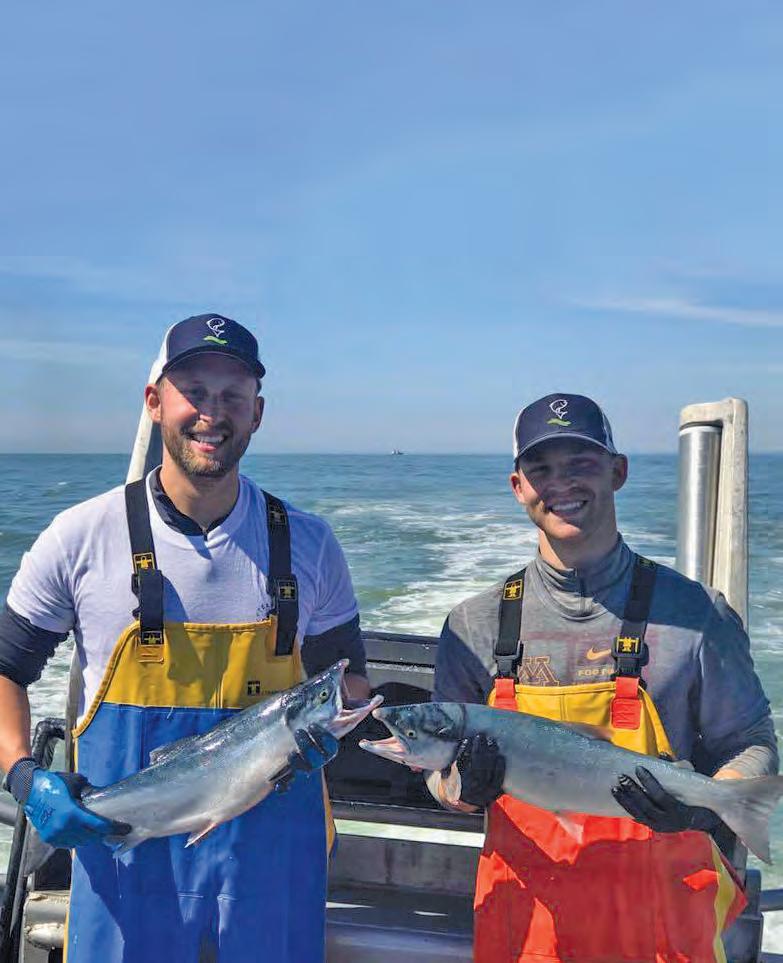


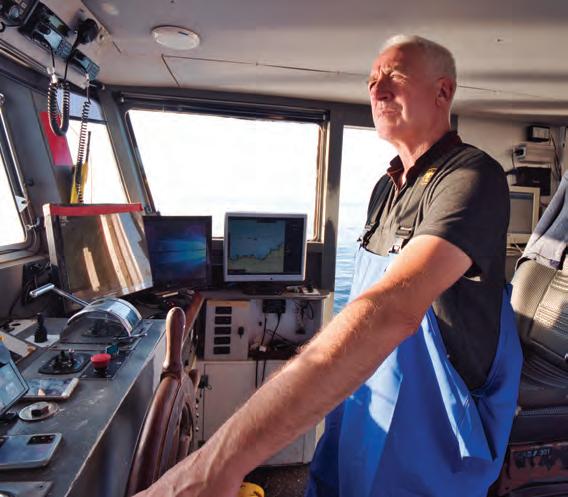
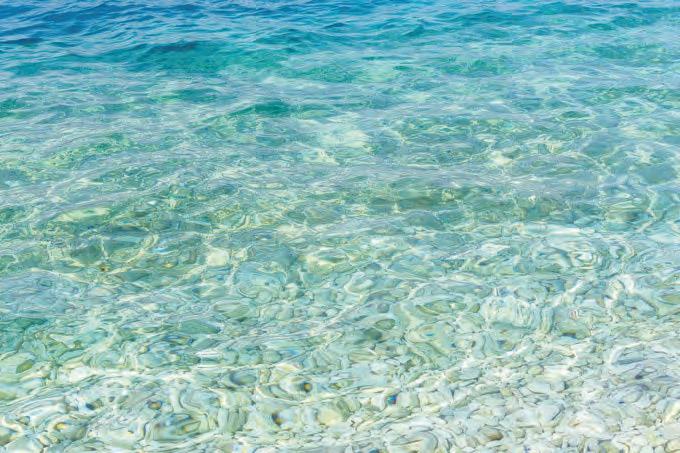











You want AI Routing! Let TZ MAPS with AI Routing make route planning a snap. Don’t take our word for it. Scan here to see for yourself how easy it is!